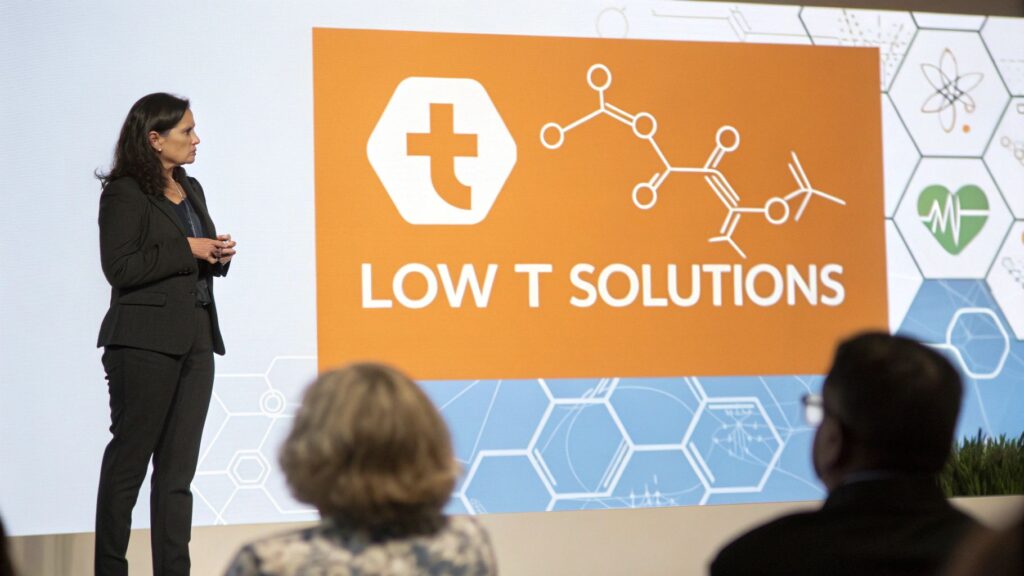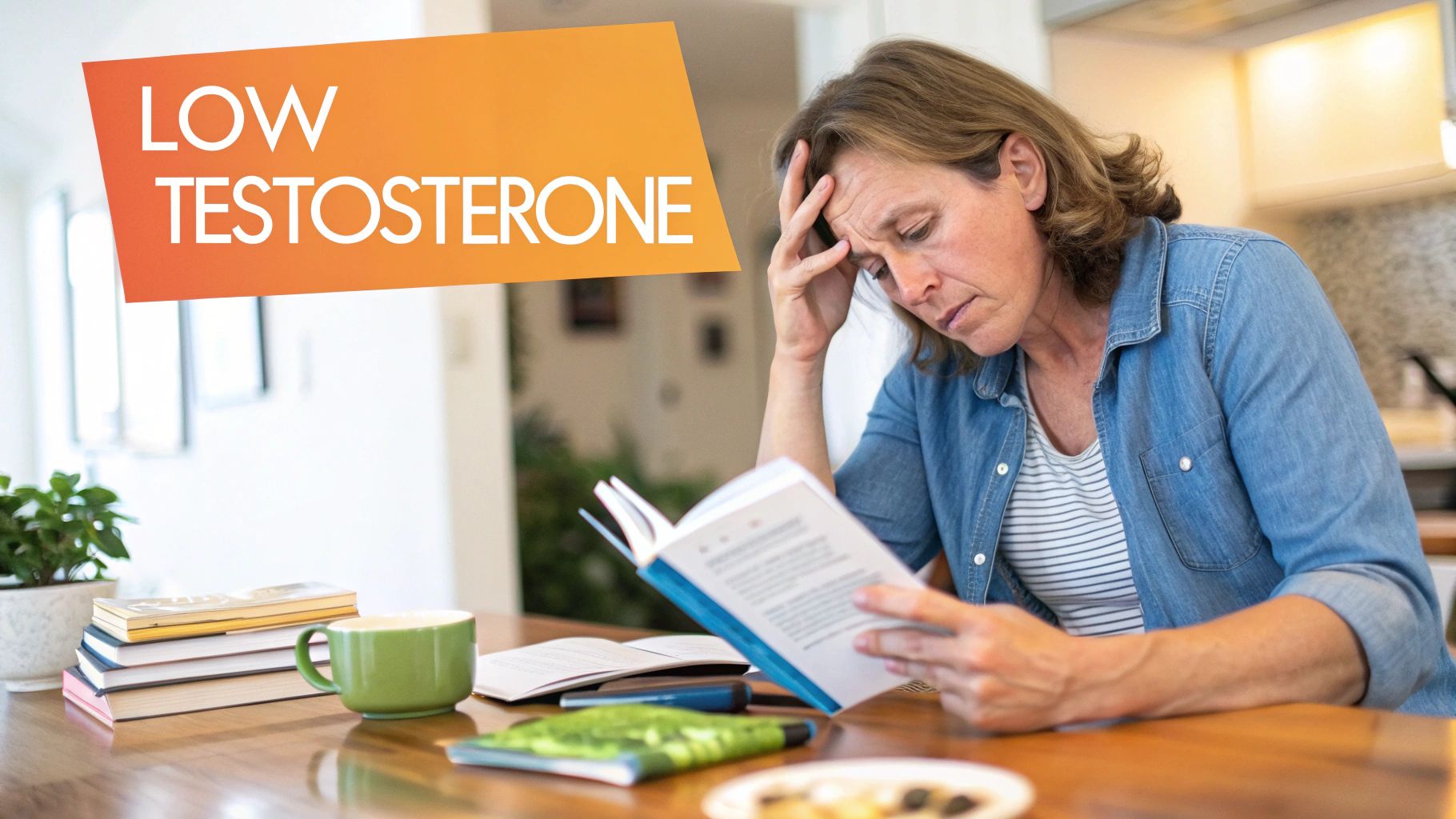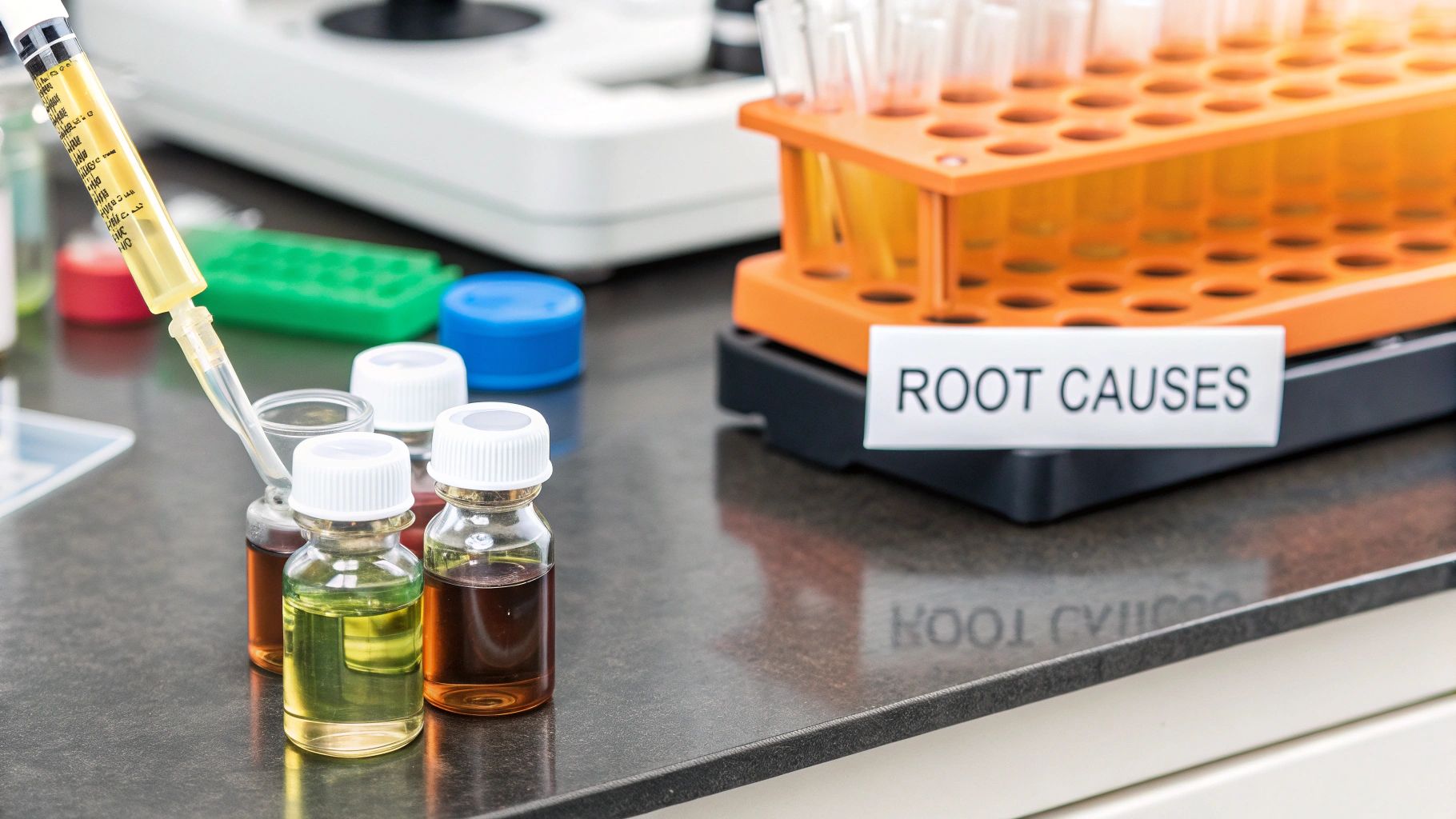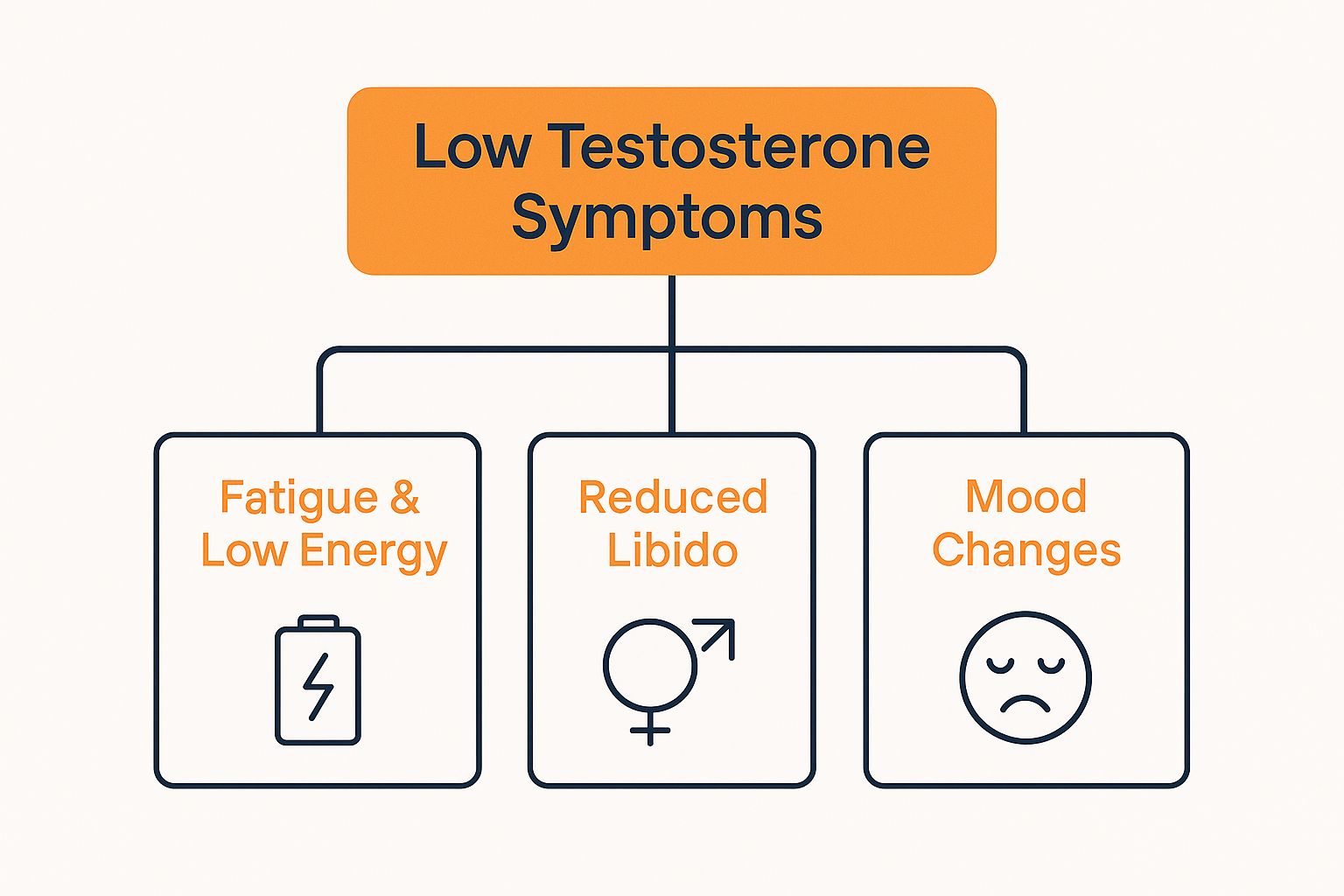Low Testosterone Symptoms in Females and Solutions

When you hear the term "low testosterone," your mind probably jumps straight to men's health. But that's only half the story. This powerful hormone plays a surprisingly crucial role in a woman's vitality, and when levels drop, it can throw your entire system off-balance. The most common signs? A sense of constant fatigue that sleep can't fix, a sex drive that's gone missing, and mood swings that come out of nowhere.
While we often associate testosterone with men, it's a critical piece of the puzzle for a woman's energy, muscle tone, and overall sense of well-being.
The Hidden Role of Testosterone in Women's Health

It’s one of the biggest myths in health that testosterone is exclusively a "male hormone." The truth is, your body’s hormones work like a finely tuned orchestra, and testosterone is a key instrument in the symphony of female health. It's produced in your ovaries and adrenal glands, and it influences everything from your energy levels to your mental clarity.
When this key instrument falls out of tune, the effects can ripple across your entire system. This isn't about one or two isolated issues; it's a hormonal imbalance that can hit your physical, emotional, and sexual health all at once. Recognizing that connection is the first real step toward figuring out what's going on.
Key Functions of Testosterone in Women
To understand why low testosterone feels so draining, it helps to know what it’s supposed to be doing in the first place. For women, this hormone has several essential jobs:
- Maintaining Muscle Mass and Bone Density: Testosterone is vital for preserving lean muscle and keeping your bones strong, which becomes even more important as you get older.
- Regulating Mood and Cognitive Function: It contributes to mental sharpness, focus, and a stable mood, helping you push back against feelings of anxiety or irritability.
- Boosting Libido and Sexual Satisfaction: This hormone is a primary driver of your sex drive and plays a huge part in overall sexual health and responsiveness.
One of the most frequently reported low testosterone symptoms in females is a nosedive in sexual desire. While hypoactive sexual desire disorder (HSDD) is officially diagnosed in about 10% of women in the US, some studies suggest that as many as 44% of women experience a significant drop in libido. This shows just how widespread this concern really is.
To quickly see how these issues connect, we've put together a simple guide to the most common symptoms.
Quick Guide to Common Low Testosterone Symptoms in Females
This table summarizes the most frequently reported physical, emotional, and sexual symptoms to help you quickly identify if this topic is relevant to your health concerns.
| Symptom Category | Common Signs to Watch For |
|---|---|
| Physical | Persistent fatigue, unexplained weight gain (especially in the midsection), muscle weakness, thinning hair, dry skin. |
| Emotional | Mood swings, increased irritability, feelings of anxiety or depression, lack of motivation, mental fog or trouble concentrating. |
| Sexual | Low libido (reduced sex drive), difficulty achieving orgasm, reduced sexual sensitivity, vaginal dryness. |
Recognizing a pattern in this list is often the first clue that your symptoms might be linked to a hormonal root cause rather than just stress or aging.
When your testosterone is low, it’s like trying to run your day on a low battery. You might feel drained, unmotivated, and mentally foggy, no matter how much rest you get.
Connecting these dots is the key to achieving proper hormonal balance for women. Symptoms like fatigue or moodiness are so often dismissed as just byproducts of a busy life. But understanding the root cause empowers you to seek the right support instead of just chasing and treating surface-level issues.
Recognizing the Subtle Signs of Low Testosterone

The signs of low testosterone rarely storm the gates. They’re much sneakier than that, creeping in so quietly they’re easy to mistake for the usual suspects: stress, aging, or just a really demanding schedule. It's so easy to write off that bone-deep fatigue as the price of a busy week or blame a flat mood on burnout, never once thinking a hormone imbalance is the real thief.
This is exactly why getting familiar with the full spectrum of low testosterone symptoms in females is so important. These signs don't pop up in isolation. Instead, they weave together into a pattern that touches your physical energy, your emotional well-being, and even your sex life. Once you learn to spot these connected clues, you can start to see the bigger picture of what’s really going on inside your body.
Physical Changes and Persistent Fatigue
One of the first and most common red flags is a deep, unshakable fatigue. This isn't your typical "I need a coffee" tiredness. It’s a profound exhaustion that a full eight hours of sleep doesn't seem to dent. You wake up feeling like you’ve barely rested, drag yourself through the morning, and then hit an absolute wall of exhaustion by 3 PM.
This relentless energy drain often shows up with a few other physical tells:
- Muscle Weakness: Your go-to workout suddenly feels like a monumental effort. You might even feel like you’re losing strength, even though you’re staying active. Just maintaining lean muscle starts to feel like a frustrating uphill battle.
- Unexplained Weight Gain: Despite sticking to a healthy diet and your regular exercise routine, you might notice the number on the scale creeping up, with new fat settling stubbornly around your middle.
- Changes in Skin and Hair: Some women notice their hair seems to be thinning, or their skin feels drier and less supple than it used to.
These aren't random occurrences. They’re signals from your body that a key hormonal player is in short supply, throwing your metabolism and cellular energy production off-kilter.
Emotional and Cognitive Symptoms
Low testosterone doesn't just hit you physically; it can cast a serious shadow over your mental and emotional world. Think of it like a fog that rolls in, dulling your focus and dampening your spirits, making simple daily tasks feel like climbing a mountain. "Brain fog" is the perfect term for it—that maddening feeling of losing your train of thought mid-sentence or struggling to concentrate on something that used to be second nature.
Low testosterone doesn't just make you tired; it can quietly erode your motivation and mental clarity, making you feel like a less vibrant version of yourself.
This cognitive slowdown often travels with a shift in mood. You might find yourself more irritable, anxious, or dealing with mood swings that feel like they come out of nowhere. A persistent feeling of apathy can also set in, making it tough to get excited about the things you used to love. These aren't character flaws—they’re often direct physiological responses to a hormone deficiency.
The Impact on Sexual Health
This is probably the most well-known symptom, but it's also the one we talk about the least. Testosterone is a major driver of libido in women, so when your levels dip, your sex drive can plummet or disappear altogether. We're not talking about a fleeting lack of interest; for many, it’s a significant and distressing change that can affect self-esteem and relationships.
This drop in desire is often joined by other issues that get in the way of sexual satisfaction. You might experience reduced sensitivity, find it harder to reach orgasm, or deal with physical discomfort like vaginal dryness. Recognizing that these challenges might be rooted in your hormonal health—not in your relationship or some personal failing—is the first, most powerful step toward finding a solution and reclaiming that important part of your life.
Understanding the Root Causes of Low Testosterone
So, why do testosterone levels drop in women? It’s almost never just one thing. A better way to think about it is to picture your hormonal balance as a delicate ecosystem—a finely tuned network where several factors can easily disrupt the harmony. Figuring out what those potential drivers are is the first step to understanding what’s really going on with your health.
The most common and predictable cause is simply the natural process of aging. A woman’s testosterone levels are at their peak in her 20s. From that point on, production starts a slow, steady decline. This shift often becomes much more noticeable around menopause, when the function of the ovaries changes dramatically.
This infographic breaks down the core symptoms that can pop up from these hormonal shifts.

As you can see, the main symptoms—fatigue, low libido, and mood changes—are all connected. It’s a perfect illustration of how a single hormonal imbalance can set off a chain reaction, affecting both your physical and emotional well-being.
Surgical and Medical Influences
While aging is a gradual process, certain medical events can cause a much more sudden and dramatic drop in testosterone. This is especially true for women who go through surgically induced menopause.
The removal of the ovaries (an oophorectomy) immediately cuts off a primary source of testosterone production. This abrupt shutdown can trigger a sharp onset of low testosterone symptoms in females, which are often far more severe than those experienced during a natural transition into menopause. In the same way, medical treatments like chemotherapy or radiation can also damage the ovaries, causing a significant drop in hormone levels.
Think of your ovaries and adrenal glands as the main factories for testosterone production. If one of these factories shuts down or has its output slashed, your body’s entire supply chain takes an immediate hit.
This direct impact is exactly why a thorough medical history is so critical for getting an accurate diagnosis.
Glandular Function and Medications
Beyond the ovaries, other parts of your endocrine system play a huge role. Your adrenal and pituitary glands are also key players in keeping your hormones regulated.
Any issues with these glands can throw the whole hormonal symphony out of tune. For instance, problems like adrenal insufficiency or a malfunctioning pituitary gland can directly interfere with testosterone synthesis, leading to a deficiency even in younger women.
Certain common medications can also mess with your hormonal landscape. Some studies have suggested that specific types of oral contraceptives may lower the amount of free, usable testosterone in the body. While birth control is essential for many, it’s a factor worth discussing with your doctor if you're dealing with symptoms that just won’t quit. Recognizing these less obvious causes helps create a much fuller picture of your unique hormonal health.
Of course. Here is the rewritten section, crafted to sound completely human-written and natural, following all the provided guidelines and examples.
Why Low T Isn’t Just a “Right Now” Problem
Dealing with the immediate symptoms of low testosterone—like fatigue and a nonexistent libido—is obviously a huge part of feeling like yourself again. But the conversation doesn't stop there. Think of balanced hormones as a foundational investment in your future health. Ignoring a deficiency is a bit like skipping the essential maintenance on your car; it might seem to run fine for a while, but you're setting yourself up for more serious trouble down the road.
Getting your testosterone levels right isn't just about today—it's a proactive strategy for lifelong wellness. We're now seeing a wave of new research that connects sustained low testosterone to some significant future health risks, completely reframing this hormone from a simple mood-and-libido booster to a key protector of your long-term vitality.
Your Heart Health and Hormonal Harmony
For years, there was a common myth that testosterone was somehow bad for a woman's cardiovascular system. Thankfully, modern research is finally turning that outdated idea on its head. The reality is that healthy testosterone levels appear to be protective for your heart.
A key study looking at women over 70 delivered a real eye-opener: those with the lowest blood levels of testosterone and DHEA had twice the risk of a major cardiovascular event compared to women with higher levels. Findings like these strongly suggest that testosterone plays a helpful, supportive role in female heart health. If you're curious, you can discover more insights about these cardiac findings and see what the researchers had to say.
Protecting Your Bones and Brain
Beyond your heart, testosterone is a vital ally for keeping your structural and cognitive health intact as you get older. It plays a direct role in how your body manages bone metabolism, helping to preserve density and strength. When those levels stay low for too long, your risk for developing osteoporosis—a condition that makes bones weak and brittle—can climb significantly.
Think of testosterone as a silent guardian for your skeleton and mind. When it's present in the right amounts, it helps keep your bones strong and your cognitive function sharp, defending against age-related decline.
On top of that, this hormone contributes to mental clarity and sharp cognitive function. While there’s still more to learn, keeping your hormones in balance is looking like an important piece of the puzzle for supporting long-term brain health and potentially lowering the risk of cognitive decline later in life. Taking care of your hormonal health today really is about safeguarding your physical and mental resilience for decades to come.
How to Get an Accurate Diagnosis
Getting to the bottom of suspected low testosterone can feel like trying to solve a complex puzzle. An accurate diagnosis isn’t just about a single number on a lab report; it’s a detailed process that pieces together proper testing with a deep dive into your unique symptoms and health history. Think of it as a skilled detective connecting all the clues to reveal the full story.
The first step is a comprehensive blood test. Your doctor will likely order a panel to measure both your total testosterone (all the testosterone floating in your bloodstream) and your free testosterone (the portion that’s unbound and readily available for your body to actually use). This distinction is critical because free testosterone is often a much better indicator of how your body is truly using the hormone.
The Challenges of Female Testosterone Testing
Diagnosing low testosterone in women comes with its own unique set of challenges. One of the biggest hurdles is that many standard lab tests are calibrated for male hormonal ranges, which are dramatically higher than what’s normal for women.
This calibration issue can make it tough to get a precise reading. A woman’s naturally lower levels can easily fall into a gray area that some tests aren't sensitive enough to measure accurately, leading to inconclusive or misleading results.
A lab result is just one piece of evidence. A skilled healthcare provider will treat your symptoms as equally important clues in the diagnostic process, looking at the entire picture rather than just a number on a page.
Because of these testing difficulties, it’s absolutely crucial to work with a provider who understands the nuances of female endocrinology. They know that how you feel is just as important as what the lab report says. For those exploring different testing methods, our guide on how to check hormone levels at home can help you understand all the available options.
Why Your Symptoms and History Matter Most
A truly accurate diagnosis happens when a healthcare provider synthesizes your test results with a thorough evaluation of your symptoms. They’ll want to know all about your energy levels, mood, sex drive, and any physical changes you’ve noticed. This holistic view is essential because the signs of low testosterone often overlap with other conditions.
In fact, the diagnostic landscape can be quite messy. A surprising study revealed that only 35.6% of women starting testosterone therapy had their levels measured beforehand. This shines a light on the real-world challenges in testing and diagnosis, with many prescriptions being based on symptoms like sexual dysfunction, depression, or even osteoporosis. You can read the full research on these diagnostic patterns to see just how intertwined these issues are.
This is precisely why your conversation with your doctor is the most powerful diagnostic tool you have. Advocating for yourself by providing a complete and honest picture of your health ensures your provider sees you, not just a lab value.
To help you get the most out of that conversation, we’ve put together a simple checklist. Being prepared helps your doctor connect the dots and ensures your concerns are heard.
Preparing for Your Doctor's Appointment
| Action Step | Why It's Important |
|---|---|
| Track Your Symptoms | Keep a simple journal for 2-4 weeks noting changes in energy, mood, sleep, and libido. Vague feelings are harder to diagnose than specific patterns. |
| List All Medications & Supplements | Include everything you take, even over-the-counter items. Some can impact hormone levels or mimic low T symptoms. |
| Document Your Health History | Mention any major illnesses, surgeries (especially hysterectomy or oophorectomy), and family history of hormonal issues. |
| Write Down Your Questions | It's easy to forget things in the moment. Having a list ensures you leave with the answers you need to feel confident. |
| Be Honest and Specific | Don't downplay sensitive topics like low sex drive or vaginal dryness. Your doctor needs the full picture to help you effectively. |
Walking into your appointment organized and ready to share this information empowers both you and your provider. It transforms the visit from a simple check-up into a collaborative effort to solve your health puzzle.
Exploring Effective Treatment Options
Once low testosterone is confirmed as the culprit behind your symptoms, the next step is finding your way back to balance. This journey is all about reclaiming your energy, vitality, and that feeling of being you. The primary path forward is Testosterone Replacement Therapy (TRT), but this is far from a one-size-fits-all fix. Modern treatments are designed with women in mind, focusing on safety, effectiveness, and fitting into your real life.
The whole point isn't to add some foreign substance to your body, but to restore what it's missing. That’s where bioidentical hormones come in. These are compounds that are molecularly identical to the hormones your body produces naturally. Using them creates a much more harmonious effect, gently bringing your levels back into a healthy, youthful range without overshooting the mark.
Finding the Right Delivery Method
TRT for women comes in several forms, each with its own pros and cons. The right choice often boils down to a mix of personal preference, lifestyle, and what your doctor determines will work best for your unique physiology. It’s all about finding a method that fits seamlessly into your routine.
The most common options include:
- Topical Creams or Gels: Applied daily to the skin—usually on the abdomen or thighs—these offer a slow, steady absorption of the hormone that mimics the body's natural rhythm. The key is consistency and being careful not to transfer the cream to anyone else through skin contact.
- Injections: These are given less frequently, providing a precise and reliable dose either into the muscle or just under the skin. While they might require a quick clinic visit or learning to self-inject, many women love the convenience of a weekly or bi-weekly schedule.
- Pellets: This is a fantastic "set it and forget it" approach. Tiny, rice-sized pellets are implanted just under the skin, where they slowly release a consistent dose of testosterone over several months. This completely eliminates the need for daily creams or regular shots. You can learn more about the specific benefits of testosterone pellets for women to see if this long-term solution is a good fit for you.
A knowledgeable provider will walk you through each option, helping you weigh the benefits to find your perfect match.

The Importance of Physiologic Dosing
One of the most crucial parts of TRT for women is a "less is more" philosophy known as physiologic dosing. The goal isn’t to jack up your testosterone levels. It’s to gently guide them back to the optimal range for female health. This careful, measured approach minimizes any risk of side effects and ensures the therapy resolves your low testosterone symptoms in females without creating new issues.
The goal of TRT is not transformation but restoration. It’s about fine-tuning your hormonal orchestra so that every instrument plays in harmony again, allowing you to feel like the best version of yourself.
This is a delicate balancing act that requires regular monitoring. Your provider will use follow-up blood tests to make sure your levels are exactly where they need to be, tailoring your dose to your body’s unique response.
With the rise of specialized telehealth platforms, getting this kind of expert, personalized care has never been easier. These services connect you with doctors who truly understand the nuances of female hormones. They offer a discreet, accessible, and supportive path to managing your symptoms and reclaiming your vitality—all from the comfort of your own home.
QUICK SEARCH
Make an account today to start your journey towards a better and healthier lifestyle.






